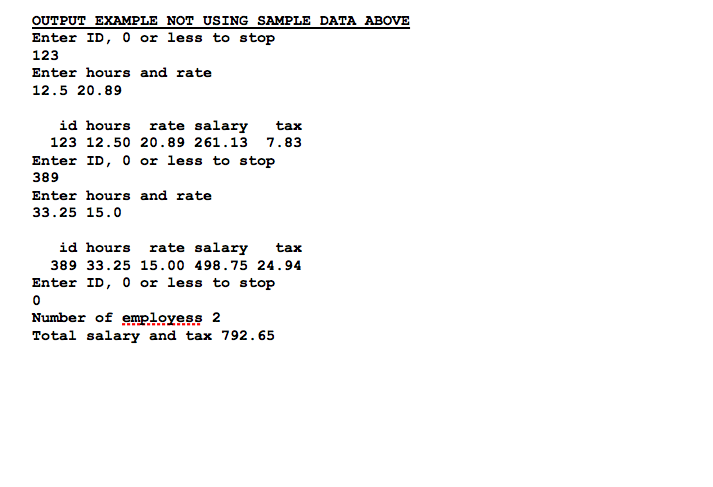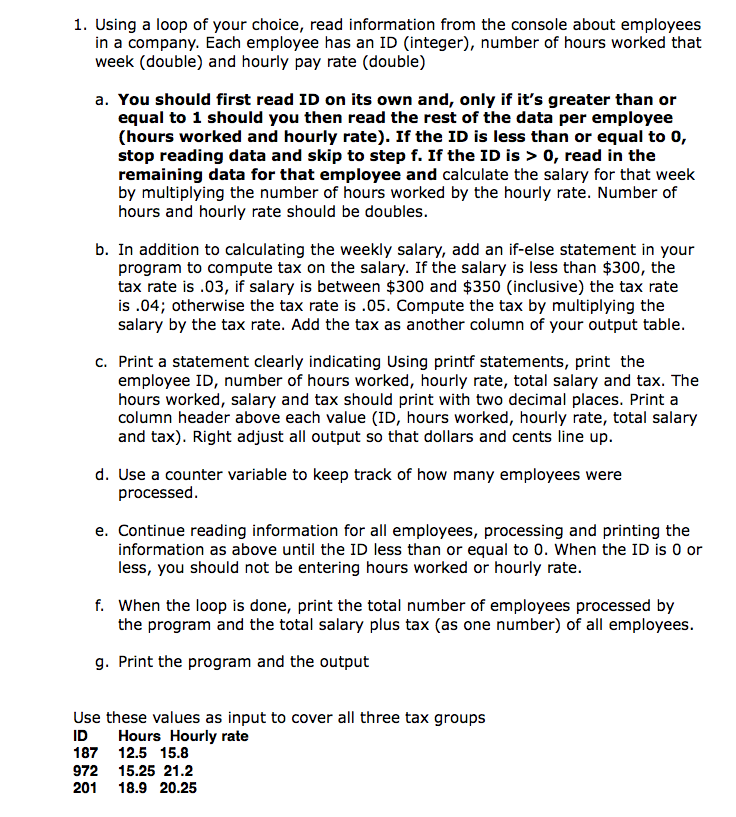1. Using a loop of your choice, read information from the console about employees in a company. Each employee has an ID (integer), number of hours worked that week (double) and hourly pay rate (double) a. You should first read ID on its own and, only if it's greater than or equal to 1 should you then read the rest of the data per employee (hours worked and hourly rate). If the ID is less than or equal to 0, stop reading data and skip to step f. If the ID is > 0, read in the remaining data for that employee and calculate the salary for that week by multiplying the number of hours worked by the hourly rate. Number of hours and hourly rate should be doubles. b. In addition to calculating the weekly salary, add an if-else statement in your program to compute tax on the salary. If the salary is less than $300, the
1. Using a loop of your choice, read information from the console about employees in a company. Each employee has an ID (integer), number of hours worked that week (double) and hourly pay rate (double) a. You should first read ID on its own and, only if it's greater than or equal to 1 should you then read the rest of the data per employee (hours worked and hourly rate). If the ID is less than or equal to 0, stop reading data and skip to step f. If the ID is > 0, read in the remaining data for that employee and calculate the salary for that week by multiplying the number of hours worked by the hourly rate. Number of hours and hourly rate should be doubles. b. In addition to calculating the weekly salary, add an if-else statement in your program to compute tax on the salary. If the salary is less than $300, the
Chapter6: Looping
Section: Chapter Questions
Problem 4GZ
Related questions
Topic Video
Question
Java using loops

Transcribed Image Text:OUTPUT EXAMPLE NOT USING SAMPLE DATA ABOVE
Enter ID, 0 or less to stop
123
Enter hours and rate
12.5 20.89
id hours rate salary
tax
123 12.50 2o.89 261.13 7.83
Enter ID, 0 or less to stop
389
Enter hours and rate
33.25 15.0
id hours
rate salary
tax
389 33.25 15.00 498.75 24.94
Enter ID, 0 or less to stop
Number of employess 2
Total salary and tax 792. 65

Transcribed Image Text:1. Using a loop of your choice, read information from the console about employees
in a company. Each employee has an ID (integer), number of hours worked that
week (double) and hourly pay rate (double)
a. You should first read ID on its own and, only if it's greater than or
equal to 1 should you then read the rest of the data per employee
(hours worked and hourly rate). If the ID is less than or equal to 0,
stop reading data and skip to step f. If the ID is > 0, read in the
remaining data for that employee and calculate the salary for that week
by multiplying the number of hours worked by the hourly rate. Number of
hours and hourly rate should be doubles.
b. In addition to calculating the weekly salary, add an if-else statement in your
program to compute tax on the salary. If the salary is less than $300, the
tax rate is .03, if salary is between $300 and $350 (inclusive) the tax rate
is .04; otherwise the tax rate is .05. Compute the tax by multiplying the
salary by the tax rate. Add the tax as another column of your output table.
c. Print a statement clearly indicating Using printf statements, print the
employee ID, number of hours worked, hourly rate, total salary and tax. The
hours worked, salary and tax should print with two decimal places. Print a
column header above each value (ID, hours worked, hourly rate, total salary
and tax). Right adjust all output so that dollars and cents line up.
d. Use a counter variable to keep track of how many employees were
processed.
e. Continue reading information for all employees, processing and printing the
information as above until the ID less than or equal to 0. When the ID is 0 or
less, you should not be entering hours worked or hourly rate.
f. When the loop is done, print the total number of employees processed by
the program and the total salary plus tax (as one number) of all employees.
g. Print the program and the output
Use these values as input to cover all three tax groups
Hours Hourly rate
ID
187 12.5 15.8
972 15.25 21.2
201
18.9 20.25
Expert Solution
This question has been solved!
Explore an expertly crafted, step-by-step solution for a thorough understanding of key concepts.
This is a popular solution!
Trending now
This is a popular solution!
Step by step
Solved in 4 steps with 2 images

Knowledge Booster
Learn more about
Need a deep-dive on the concept behind this application? Look no further. Learn more about this topic, computer-science and related others by exploring similar questions and additional content below.Recommended textbooks for you

EBK JAVA PROGRAMMING
Computer Science
ISBN:
9781337671385
Author:
FARRELL
Publisher:
CENGAGE LEARNING - CONSIGNMENT

C++ Programming: From Problem Analysis to Program…
Computer Science
ISBN:
9781337102087
Author:
D. S. Malik
Publisher:
Cengage Learning

Microsoft Visual C#
Computer Science
ISBN:
9781337102100
Author:
Joyce, Farrell.
Publisher:
Cengage Learning,

EBK JAVA PROGRAMMING
Computer Science
ISBN:
9781337671385
Author:
FARRELL
Publisher:
CENGAGE LEARNING - CONSIGNMENT

C++ Programming: From Problem Analysis to Program…
Computer Science
ISBN:
9781337102087
Author:
D. S. Malik
Publisher:
Cengage Learning

Microsoft Visual C#
Computer Science
ISBN:
9781337102100
Author:
Joyce, Farrell.
Publisher:
Cengage Learning,

Programming Logic & Design Comprehensive
Computer Science
ISBN:
9781337669405
Author:
FARRELL
Publisher:
Cengage